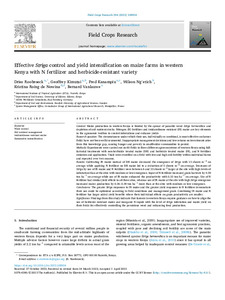| dc.contributor.author | Roobroeck, D. |
| dc.contributor.author | Kimutai, G. |
| dc.contributor.author | Kanampiu, F. |
| dc.contributor.author | Ng'etich, W. |
| dc.contributor.author | Roing de Nowina, K. |
| dc.contributor.author | Vanlauwe, B. |
| dc.date.accessioned | 2023-04-11T08:49:56Z |
| dc.date.available | 2023-04-11T08:49:56Z |
| dc.date.issued | 2023-05-15 |
| dc.identifier.citation | Roobroeck, D., Kimutai, G., Kanampiu, F., Ng'etich, W., Roing de Nowina, K. & Vanlauwe, B. (2023). Effective Striga control and yield intensification on maize farms in western Kenya with N fertilizer and herbicide-resistant variety. Field Crops Research, 296: 108924, 1-8. |
| dc.identifier.issn | 0378-4290 |
| dc.identifier.uri | https://hdl.handle.net/20.500.12478/8123 |
| dc.description.abstract | Context Maize production in western Kenya is limited by the spread of parasitic weed Striga hermonthica and depletion of soil nutrient stocks. Nitrogen (N) fertilizer and imidazolinone resistant (IR) maize are key elements in the agronomic toolbox to control infestations and enhance yields Research question The circumstances under which their use, individually or combined, is most effective on farmer fields have not been well documented. Inappropriate management decisions and low returns on investments arise from this knowledge gap, causing hunger and poverty in smallholder communities to persist. Methods Experiments were carried out on 60 fields in three different agroecosystems of western Kenya using full-factorial treatments with non-herbicide treated maize (DH) and herbicide treated maize (IR), and N fertilizer omission and application. Trials were stratified on a field with low and high soil fertility within individual farms and repeated over two seasons. Results Cultivating IR maize instead of DH maize decreased the emergence of Striga with 13 shoots m−2 on average while applying N fertilizer on DH maize led to a reduction of 5 shoots m−2 on average. Decreases of Striga by use of IR maize and N fertilizer were between 6 and 23 shoots m−2 larger at the site with high levels of infestation than at the sites with medium or low emergence. Input of N fertilizer increased grain harvests by 0.59 ton ha−1 on average while use of IR maize enhanced the productivity with 0.33 ton ha−1 on average. Use of N fertilizer had similar yield effects in all three sites, whereas use of IR maize at the site with high Striga emergence increased maize production by 0.26–0.39 ton ha−1 more than at the sites with medium or low emergence. Conclusions The greater Striga responses to IR maize and the greater yield responses to N fertilizer demonstrate their use could be optimized according to field conditions and management goals. Combining IR maize and N fertilizer has larger added yield benefits where their individual effects on grain productivity are smaller. Significance Findings from this study indicate that farmers in western Kenya require guidance on how to align the use of herbicide resistant maize and inorganic N inputs with the level of Striga infestation and maize yield on their fields for effectively controlling the pernicious weed and enhancing food production. |
| dc.description.sponsorship | Swedish University of Agricultural Sciences |
| dc.description.sponsorship | Bill & Melinda Gates Foundation |
| dc.format.extent | 1-8 |
| dc.language.iso | en |
| dc.subject | Weed Control |
| dc.subject | Soil Fertility |
| dc.subject | Maize |
| dc.subject | Striga |
| dc.subject | Sustainable Intensification |
| dc.subject | Kenya |
| dc.title | Effective Striga control and yield intensification on maize farms in western Kenya with N fertilizer and herbicide-resistant variety |
| dc.type | Journal Article |
| cg.contributor.crp | Grain Legumes |
| cg.contributor.crp | Maize |
| cg.contributor.crp | Roots, Tubers and Bananas |
| cg.contributor.affiliation | International Institute of Tropical Agriculture |
| cg.contributor.affiliation | University of Eldoret |
| cg.contributor.affiliation | GOPA Worldwide Consultants, Germany |
| cg.contributor.affiliation | Swedish University of Agricultural Sciences |
| cg.contributor.affiliation | Consultative Group on International Agricultural Research |
| cg.coverage.region | Africa |
| cg.coverage.region | East Africa |
| cg.coverage.country | Kenya |
| cg.coverage.hub | Central Africa Hub |
| cg.researchtheme | Natural Resource Management |
| cg.identifier.bibtexciteid | ROOBROECK:2023 |
| cg.isijournal | ISI Journal |
| cg.authorship.types | CGIAR and developing country institute |
| cg.iitasubject | Agronomy |
| cg.iitasubject | Disease Control |
| cg.iitasubject | Food Security |
| cg.iitasubject | Maize |
| cg.iitasubject | Plant Breeding |
| cg.iitasubject | Plant Production |
| cg.iitasubject | Soil Fertility |
| cg.journal | Field Crops Research |
| cg.notes | Open Access Article; Published online: 04 Apr 2023 |
| cg.accessibilitystatus | Open Access |
| cg.reviewstatus | Peer Review |
| cg.usagerightslicense | Creative Commons Attribution 4.0 (CC BY 0.0) |
| cg.targetaudience | Scientists |
| cg.identifier.doi | https://doi.org/10.1016/j.fcr.2023.108924 |
| cg.iitaauthor.identifier | Dries Roobroeck: 0000-0003-3176-4444 |
| cg.iitaauthor.identifier | Fred Kanampiu: 0000-0002-2480-6813 |
| cg.iitaauthor.identifier | bernard vanlauwe: 0000-0001-6016-6027 |
| cg.futureupdate.required | No |
| cg.identifier.issue | 108924 |
| cg.identifier.volume | 296 |

